33-Year-Old Asks: Is My SIP Portfolio Okay? Should I Invest in Land or More Mutual Funds?
Ramalingam Kalirajan |10870 Answers |Ask -Follow
Mutual Funds, Financial Planning Expert - Answered on Jul 27, 2024
He has an MBA in finance from the University of Madras and is a certified financial planner.
He is the director and chief financial planner at Holistic Investment, a Chennai-based firm that offers financial planning and wealth management advice.... more

Iam 33yrs old..strtd doing sip of 30k in below MF 1) qunt elss tax ( 10k) 2) motilal oswal nifty midcap 150index (4.5k) 3) parag pareikh flexi cap ( 4k) 4)canara rebeco smal cap( 3.5k) 5)pgim india midcap (2k) 6)axis growth oppurtunty (3.5k) 7) qunt dynamic asset allocation( 2.5k) Is my selection okay?. Apart from that i have around 52lk in banks not sure whether to keep that in MF or in buying any plot for investment please guide. Also invested 3.5lk in stocks.. no loans for now earning around 1.5lk PM
ELSS Tax Fund: Rs. 10,000
Mid Cap Index Fund: Rs. 4,500
Flexi Cap Fund: Rs. 4,000
Small Cap Fund: Rs. 3,500
Mid Cap Fund: Rs. 2,000
Growth Opportunity Fund: Rs. 3,500
Dynamic Asset Allocation Fund: Rs. 2,500
Evaluation of Your Portfolio
1. ELSS Tax Fund
Investing Rs. 10,000 in an ELSS fund helps you save taxes under Section 80C. It also provides potential for long-term growth.
2. Mid Cap Index Fund
Mid cap index funds track the mid cap segment. However, they do not adjust to market changes. Actively managed mid cap funds can offer better returns.
3. Flexi Cap Fund
Flexi cap funds invest across market caps. This provides flexibility and diversification. Your Rs. 4,000 investment is a good choice.
4. Small Cap Fund
Small cap funds can offer high returns but come with higher risk. Your Rs. 3,500 investment is suitable for aggressive growth.
5. Mid Cap Fund
Mid cap funds balance risk and reward. They offer growth potential with moderate risk. Your Rs. 2,000 investment is well-placed.
6. Growth Opportunity Fund
These funds focus on growth-oriented stocks. They can deliver high returns. Your Rs. 3,500 investment aligns with growth objectives.
7. Dynamic Asset Allocation Fund
These funds adjust their equity-debt mix based on market conditions. They provide growth with stability. Your Rs. 2,500 investment is a wise choice.
Disadvantages of Index Funds
Index funds mimic the market. They do not adjust to changing market conditions. This can limit potential returns. Actively managed funds offer professional management and adapt to market changes, often delivering better performance.
Disadvantages of Direct Funds
Direct funds require constant monitoring and active management. This can be time-consuming and complex. Regular funds, managed through a Certified Financial Planner (CFP), offer professional advice and portfolio management.
Recommendations for Additional Investments
You have Rs. 52 lakhs in the bank and are considering investing it. Here are some suggestions:
1. Balanced Advantage Funds
These funds dynamically adjust the equity-debt mix. They provide growth with reduced risk.
2. Debt Funds
Debt funds provide stability and regular income. They are good for balancing your portfolio.
3. International Funds
These funds invest in global markets. They offer diversification beyond Indian markets.
4. Liquid Funds
Liquid funds offer high liquidity and are ideal for short-term needs. They provide better returns than a savings account.
Investing in Mutual Funds vs. Buying Property
Investing in mutual funds can provide better liquidity and diversification. Real estate investments require a larger capital outlay and involve risks such as market fluctuations, maintenance, and legal issues.
Systematic Investment Plan (SIP)
Continue with your SIP approach. It helps in disciplined investing and averaging out the purchase cost, reducing market timing risk.
Regular Portfolio Review
Regularly review your portfolio. Ensure it aligns with your goals and risk tolerance. Make adjustments as needed.
Consult a Certified Financial Planner
A CFP can provide tailored advice. They offer professional portfolio management and ensure your investments align with your financial goals.
Final Insights
Your current mutual fund investments are diversified and aligned with your financial goals. Consider replacing the index fund with an actively managed fund for better returns.
Invest additional funds in balanced advantage, debt, international, and liquid funds. Continue with SIPs and consult a CFP for professional advice.
Best Regards,
K. Ramalingam, MBA, CFP,
Chief Financial Planner,
www.holisticinvestment.in
You may like to see similar questions and answers below
Ramalingam Kalirajan |10870 Answers |Ask -Follow
Mutual Funds, Financial Planning Expert - Answered on May 30, 2024
Dev Ashish | Answer |Ask -Follow
MF Expert, Financial Planner - Answered on Sep 30, 2023
Ramalingam Kalirajan |10870 Answers |Ask -Follow
Mutual Funds, Financial Planning Expert - Answered on Aug 21, 2024
Ramalingam Kalirajan |10870 Answers |Ask -Follow
Mutual Funds, Financial Planning Expert - Answered on Jul 11, 2024
Naveenn Kummar |233 Answers |Ask -Follow
Financial Planner, MF, Insurance Expert - Answered on Oct 13, 2025
Dr Dipankar Dutta |1837 Answers |Ask -Follow
Tech Careers and Skill Development Expert - Answered on Dec 05, 2025
Dr Shyam Jamalabad |108 Answers |Ask -Follow
Dentist - Answered on Dec 05, 2025
Dr Shyam Jamalabad |108 Answers |Ask -Follow
Dentist - Answered on Dec 05, 2025
Dr Shyam Jamalabad |108 Answers |Ask -Follow
Dentist - Answered on Dec 05, 2025
Dr Dipankar Dutta |1837 Answers |Ask -Follow
Tech Careers and Skill Development Expert - Answered on Dec 05, 2025
Ulhas Joshi |280 Answers |Ask -Follow
Mutual Fund Expert - Answered on Dec 05, 2025
Dr Dipankar Dutta |1837 Answers |Ask -Follow
Tech Careers and Skill Development Expert - Answered on Dec 04, 2025
Ravi Mittal |676 Answers |Ask -Follow
Dating, Relationships Expert - Answered on Dec 04, 2025
Anu Krishna |1745 Answers |Ask -Follow
Relationships Expert, Mind Coach - Answered on Dec 04, 2025
Anu Krishna |1745 Answers |Ask -Follow
Relationships Expert, Mind Coach - Answered on Dec 04, 2025




























